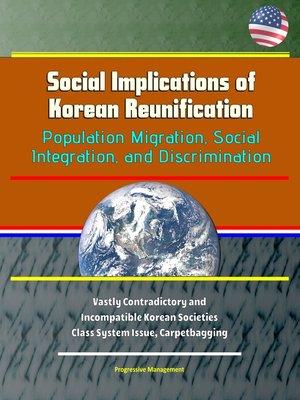Social Implications of Korean Reunification
ebook ∣ Population Migration, Social Integration, and Discrimination--Vastly Contradictory and Incompatible Korean Societies, Class System Issue, Carpetbagging

Sign up to save your library
With an OverDrive account, you can save your favorite libraries for at-a-glance information about availability. Find out more about OverDrive accounts.
Find this title in Libby, the library reading app by OverDrive.



Search for a digital library with this title
Title found at these libraries:
| Library Name | Distance |
|---|---|
| Loading... |
This report has been professionally converted for accurate flowing-text e-book format reproduction. Existing literature on the topic of a potential Korean reunification focuses primarily on three major areas of concern: the impact to regional and international security, fiscal costs analysis, and anticipation of various reunification scenarios. Assuming a unification under Seoul's guidance, this study will seek to bridge a gap that exists in the field by examining the likely social implications of reunification on the Korean peninsula. It will argue that despite the similarities in culture, language, historical legacies, and ethnic roots, two particular sets of social issues—population migration and social discrimination—will prove to be more divisive and socially costly than those similar issues experienced in the aftermath of the German reunification. This study will conclude that seven decades of separation has created two vastly contradictory and incompatible Korean societies that will make the social integration of the two Koreas as sensitive, challenging, and complex as the more often debated security and economic repercussions. As such, the potential social implications should be discussed on an equal footing with security and economic consequences of the Korean reunification.
This compilation includes a reproduction of the 2019 Worldwide Threat Assessment of the U.S. Intelligence Community.
This study consists of six chapters. Chapter II explains the strongest rationale for the Korean reunification: shared ethnic identity. It reviews the ethnic historicity that unites North and South Koreans in a single ethnic identity, defines preconditions for being Korean, and highlights the evolution of intra-South Korean national identity, which is undergoing significant changes, particularly among the younger generations. In doing so, Chapter II seeks to debunk the prevalent "blood-bound notion" of ethnic unity that is often "expected to function as a unifying force across a divided system." Chapter III examines the North-South migration and population movement that is expected in a unified Korea. This migration flow is further sub-analyzed with regard to shifts in motivations for defection, growth of the labor crowing effect, and exacerbation of infrastructure limitations and socio-spatial inequality. Chapter III outlines the myriad of social complications that will arise when North Koreans crowd South Korea's already competitive labor market; compete for basic and critical government services, limited housing, and schools; and demand more from an already over-stretched South Korean infrastructure. Chapter IV explores social discrimination and the probable emergence of a class system, analyzed in the context of the split of pan-Korean nationalism into two factions of South Korean "Us" and North Korean "Them." It examines the reasons behind the growing social distance between North and South Koreans, and notes differences between northern and southern cultural and societal values. Chapter IV also addresses the potential social discrimination challenges that the North Korean defectors will face when assimilating into a vastly different southern society, and argues that social integration will come with an underlying layer of discrimination and classification of North Koreans as "second class citizens who form a new minority group in the South Korean society."







